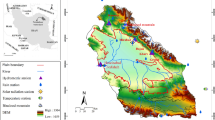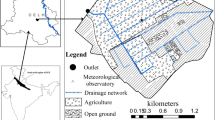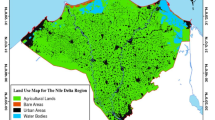Abstract
This paper describes the impact of rice hydraulic loading (percentage area under rice crop) on groundwater levels and salinity in the Murrumbidgee irrigation area (MIA), Australia using a MODFLOW-based modelling approach. The model simulations show that the groundwater levels will be in equilibrium after a fall of approximately 1 m under most of the areas, however, the groundwater salinity levels will rise by more than 1,000 μs/cm in most parts of irrigation area. If the rice growing area is reduced by 50 and 75%, there can be a net decline in groundwater levels during the first 2 years and then a new quasi-equilibrium will be established. To downscale these results at the farm level, SWAGMAN Farm model in conjunction with groundwater outflow rates obtained from a three-dimensional MODFLOW model was applied for determining net recharge rates under rice for different areas within the MIA. The highest net recharge during 2005–2006 season was 0.84 ML/ha (84 mm) in parts of the irrigation system, whereas the average net recharge due to rice hydraulic loading for the whole MIA during 2005–2006 season was estimated as 0.34 ML/ha (34 mm).











Similar content being viewed by others
References
Anan M, Yuge K, Nakano Y, Saptomo S, Haraguchi T (2007) Quantification of the effect of rice paddy area changes on recharging groundwater. Paddy Water Environ 5:41–47. doi:10.1007/s10333-006-0059-1
Bouman BAM, Wopereis MCS, Kropff MJ, ten Berge HFM, Tuong TP (1994) Water use efficiency of flooded rice fields: (II) percolation and seepage losses. Agric Water Manage 26:291–304
Brumbelow K, Georgakakos A (2007) Consideration of climate variability and change in agricultural water resources planning. ASCE J Water Resour Plann Manage 133(3):275–285
Chen SK, Liu CW (2002) Analysis of water movement in paddy rice fields: (I) experimental studies. J Hydrol 260:206–215
Chen SK, Liu CW, Huang HC (2002) Analysis of water movement in paddy rice fields: (II) numerical simulations. J Hydrol 265:259–271
Chiang W, Kinzelbach W (1998) Processing MODFLOW user manual. Scientific Software Group, Washington, DC
Cooperative Research Centre (CRC) for Sustainable Rice Production (2003) Annual Report 2000–2001. NSW DPI, CRC Rice, Yanco, NSW
Elhassan AM, Goto A, Mizutani M (2001) Combining a tank model with a groundwater model for simulating regional groundwater low in an alluvial fan. Trans Jpn Irrig Drain Reclam Eng 9(5):583–591
Gates T (1997) Sabbatical visit report to CSIRO land and water, Australia
Khan S (2007) Equivalent cropping area and whole farm water balance approaches to reduce net recharge to shallow saline groundwater from rice based cropping systems. Paddy Water Environ, 5:143–152. doi:10.1007/s10333-007-0078-6
Khan S, Xevi E, Meyer WS (2003) Salt, water and groundwater management models to determine sustainable cropping patterns in shallow saline groundwater regions (Special volume of the J Crop Prod titled Crop production in saline environments 325–340) Co-published simultaneously In: SS Goyal, SK Sharma, Williams D (eds) Crop production in saline environments, global and integrative perspectives. Haworth Press, New York
Khan S, Rana T, Carroll J, Wang B and Best L (2004a) Managing climate, irrigation and ground water interactions using a numerical model: a case study of the Murrumbidgee irrigation area. CSIRO Land and Water Technical Report No. 13/04. Available online at http://www.clw.csiro.au/publications/technical2004/tr13-04.pdf
Khan S, Rana T, Beddek R, Paydar Z, Carroll J, Blackwell J (2004b) Whole of catchment water and salt balance to identify potential water saving options in the Murrumbidgee catchment. Working Paper of the Pratt Water Murrumbidgee Valley Water Efficiency Project, CSIRO, Griffith
Khan S, Rana T, Yuanli C, Blackwell J (2006) Can irrigation be sustainable? Agric Water Manage 80:87–99
Khan S, O’Connell N, Rana T, Xevi E (2007) Hydrologic-economic model for managing irrigation intensity in irrigation areas for water table and soil salinity targets. Environ Model Assess. doi:10.1007/s10666-006-9081-3
Knisel WG, Leonard RA (1989) Irrigation impact on groundwater: model study in humid region. J Irrig Drain Eng 15(5):823–838
Kumar R, Singh J (2003) Regional water management modelling or decision support in irrigated agriculture. J Irrig Drain Eng 29(6):432–439
Lecina S, Playán E (2006) Model for the simulation of water flows in irrigation districts II: application. ACSE J Irrig Drain Eng 132(4):322–330. doi:10.1061/(ASCE)0733-9437(2006)132:4(322)
Leslie D (1992) Rice 2000: environmental policy paper. Dwyer Leslie Pty Ltd, Canberra
MacDonald MG, Harbaugh AW (1988) A modular three dimensional finite difference groundwater flow model. United States Geological Survey (USGS). Reston, Virginia
Middlemis H (2001) Murray Darling Basin Commission’s groundwater flow modelling guidelines. Aquaterra Consulting Pty Ltd, Perth
Minciardi R, Robba M, Sacile R (2007) Decision models for sustainable groundwater planning and control. Control Eng Pract 15:1013–1029. doi:10.1016/j.conengprac.2006.10.017
Murrumbidgee Irrigation Limited (MIL) (2001) Working for you with you. Murrumbidgee Irrigation, Griffith, NSW
NSW Agriculture (1998) MIA and districts LWMP. NSW Agriculture, Yanco, NSW
Pisinaras V, Petalas C, Tsihrintzis V A and Zagana E (2006) A groundwater flow model for water resources management in the Ismarida plain, north Greece. Environ Model Assess. doi:10.1007/s10666-006-9040-z
Prathapar SA (1994) SWAGSIM: A soil water and groundwater simulation model. CSIRO Division of Water Resources, Report 94/3 Griffith, NSW
Punthakey JF, Someratne NM, Prathapar SA, Merrick NP, Lawson S, Williams RM (1994) Regional groundwater modelling of the Lower Murrumbidgee River Basin: Model development and calibration. Department of Water Resources Technical Services Division, Murrumbidgee Region, Leeton, NSW
Rojas R, Dassargues A (2007) Groundwater flow modelling of the regional aquifer of the Pampa del Tamarugal, northern Chile. Hydrogeol J 15:537–551. doi:10.1007/s10040-006-0084-6
Saleh AF, Steenhuis TS, Walter MF (1989) Groundwater table simulation under different rice irrigation practice. J Irrig Drain Eng 115(4):530–544
Singh RP, Mullen JD, Jayasuriya RT (2005) Farming systems in the Murrumbidgee irrigation area in NSW. Economic Research Report No. 10, NSW Department of Primary Industries, Yanco, NSW. http://www.agric.nsw.gov.au/reader/10550
Sophocleous M, Perkins SP (2000) Methodology and application of combined watershed and ground-water models in Kansas. J Hydrol 236:185–201
Van der Lely A (1998) Soil salinity assessment and prediction model: review of methodology for irrigated areas in New South Wales (NSW). Department of Land and Water Conservation Report for the CRC for the Sustainable Rice Production, Leeton, NSW
Walker SH, Rushton KR (1984) Verification of lateral percolation losses from irrigated rice fields by a numerical model. J Hydrol 71:335–351
Winston RB (1999) MODFLOW—related freeware and shareware resources on the internet. Comput Geosci 25:377–382
Zheng C (1996) MT3D Version DoD_1.5: a modular three-dimensional transport model. The Hydrogeology Group, University of Alabama, AL
Acknowledgments
Collection of river and channel network cross sections data by Ms Nicola King is acknowledged. The funding support of the Murrumbidgee Irrigation and the CRC for the Sustainable Rice Production made this work possible.
Author information
Authors and Affiliations
Corresponding author
Rights and permissions
About this article
Cite this article
Khan, S., Rana, T., Carroll, J. et al. Assessment of rice hydraulic loading impacts on groundwater and salinity levels. Paddy Water Environ 8, 23–39 (2010). https://doi.org/10.1007/s10333-009-0171-0
Received:
Accepted:
Published:
Issue Date:
DOI: https://doi.org/10.1007/s10333-009-0171-0




